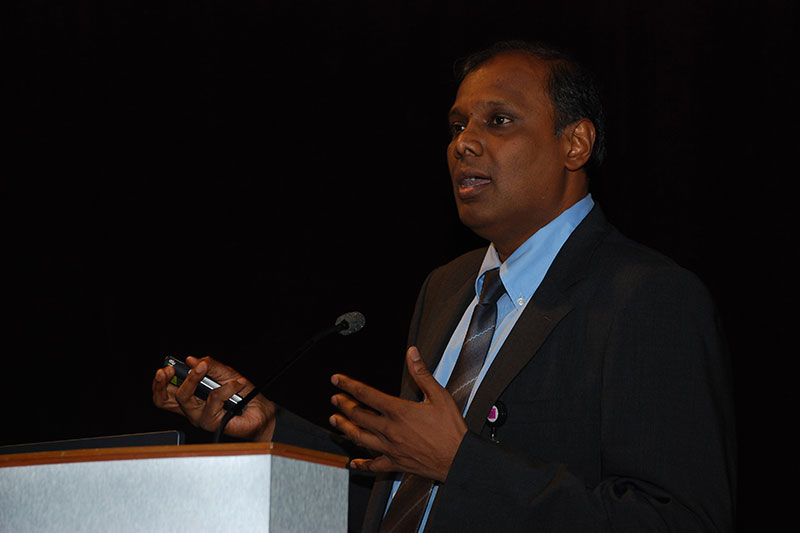
This is the second part (click here for Part 1) of the interview with Thillai Raj T Ramanathan, Chief Technology Officer of MIMOS Berhad. We learn about the benefits of a common development platform, boosting industry adoption of Internet of Things (IoT) and security.
What was the effect of the demonstration of IoT application on industry?
When we showed these real life applications of IoT to the industry, they started coming up with other solutions using the same platform.
For instance, you might need to project what’s on your computer display on to a screen through a projector. It can get very messy with different kinds of cables. During MyIoT week, a local company came up with a wireless way of projecting.
It takes display signals from all your computers, notebooks, even Android devices and sends them to the Mi-MIST platform, which translates and harmonises the data, which can then be projected. In big conferences now, if many people want to project, you don’t need to move HDMI and VGA cables around. You just have to click the app and it will automatically link and go to the middleware.
Instead of companies developing their own middleware, they can just take Mi-MIST, develop applications and sell the product. This shortens their time to market. Also, they don’t have to spend money in researching how to do this. This reduces the risk for SMEs to go into new product development.
The idea behind all this is when you are trying to promote IoT and big data, companies might be held back by concerns over investment and monetisation. The smaller companies might not be able to afford hiring a full team of 20-30 engineers and then wait for 5 years before they see returns. So, we shorten the process by developing the technology. The end-users are interested in only end-to-end solutions. We believe this will accelerate IoT adoption in the country.
Once they are mature enough, they can do their own Mi-MIST. But for now, we can get the ball rolling. We use the government funding and pass on the benefits to industry for promoting innovation and getting wider public benefits.
Are there plans to implement the durian kind of tracking system elsewhere?
After the successful implementation of the durian tracking, the Malaysian Durian Exporters Association actually formed a tech company called MyTraceabilitySdn Berhad. They want to implement this technology in many other areas, specifically for food. It can be used for all sorts of agricultural produce.
This is an excellent example of opening the eyes of people from industries, who are not traditionally tech-savvy. Now they are selling tech products which have direct value for business!
Are you looking at emerging technologies like deep learning?
We recently conducted a deep learning workshop, attended by around 200 people, for educating local universities and local companies. We are already using it for some things. The video analytics I mentioned earlier uses deep learning methods.
How we capture lots of data, then do deep learning on it and deploy libraries to the field, so that the devices in the field are very light, they don’t have to be heavy. You can do the work upfront. We are working with GPU vendors also.
What measures are you taking for dealing with cyberthreats?
In Malaysia, a couple of years ago, we introduced a Personal Data Protection Act (PDPA). That is more from the policy perspective. We are funded by the government to explore technologies which can help safeguard the privacy of the individual and even the machine.
We are looking at how to take the data stored online, break it up into many pieces, store the pieces in many different locations. Then the data cannot be used, unless you have all the pieces and you put them together. At the same time, we anonymise your name so that even if someone has one piece, they won’t be able to use it and they won’t even know who it belongs to.
The government is beginning to take cybersecurity very seriously because they can see the risks. In April, CGSO, MAMPU, MIMOS co-authored a Public Sector Cyber Security Framework. Among other things, it prescribes levels of security and authentication for different classifications of data.
Similarly, there are requirements for storing different types of data. Confidential data cannot be stored together with data meant for public use. There is mandatory physical separation of servers and storage. All these are spelt out clearly in the document. We are encouraging the government to follow this document for all IT projects. Everybody has to follow these guidelines. As new projects come in, they begin to adapt to the document and move forward.
It is a living document. We will keep adding to it, as we understand more about cybersecurity or as threats evolve.
This indirectly affects the private sector too. They are the ones who supply applications to the government. So, they also have to comply with the requirement, if they want to work with government. Then they can apply the same techniques to private industry. That way, we keep improving security and privacy of the whole ecosystem.
Do you collaborate with other agencies?
Last year, we brought in 40 people from government and industry into MIMOS. Industry representatives included telecoms and local and multinational corporations. We also brought in people from regulators like Malaysian Communications and Multimedia Commission (MCMC). Working together we drafted the National Internet of Things Strategic Roadmap and released it in July 2015.
The roadmap will be spearheaded by MOSTI. It is a blueprint but it will be updated as we go along, as things change.
This document is a guide on how the government and private sector will work on IoT together. Based on this we started collaboration projects and created proof-of-concepts. The objective was to get everyone on the same page. In its absence, there would have been many parallel efforts resulting in wasted resources. The various stakeholders are welcome to provide comments.
To facilitate this, we opened BITX (Big Data IoT Technology Accelerator) Lab. It deals with three areas, the network side, the application side and the device side. Mi-MIST is the glue connecting them. It serves as a technology reference centre that facilitates innovation. When some company wants to design an application, test a network or test applications, this lab provides the equipment, facilities and human expertise to help the SMEs to move forward. It provides software and hardware support and infrastructure.
We see them coming here, checking network protocols and security, testing interoperability between devices, measuring application performance. It is sponsored by the government and there is no cost to the companies. They can merely register, come in to the lab and log in and use any equipment they need.
Where do you see Malaysia ten years from now in terms of digital connectivity?
We want to have a connected Malaysia but we need to very diligent about security. Connectivity presents massive advantages. But in the wrong hands it could be misused.
Cyberwarfare might become more important than actual physical warfare. Malaysia has to invest a lot of time, looking at security, along with things like IoT and Big data. At the same time, we need to attain a fine balance, between putting too many bottlenecks in the name of security and jeopardising security in the rush to adopt technologies.
How do we have the convenience of a connected Malaysia, coupled with robust security and privacy. Do we leave the systems open or closed? Where might the optimum lie? Policy makers might want everything secure while the public wants everything open. This is a global issue. I think it will take us at least the next 5-6 years to iron out these wrinkles.
Earlier Malaysia was reliant on plantations (rubber, palm oil) and mines (tin). We gradually moved to a manufacturing economy. With IoT and big data we are making the next shift to a knowledge economy. Agriculture and manufacturing will continue to play their roles but it will be healthy mix in 8-10 years.
Read the first part of the interview here.
















